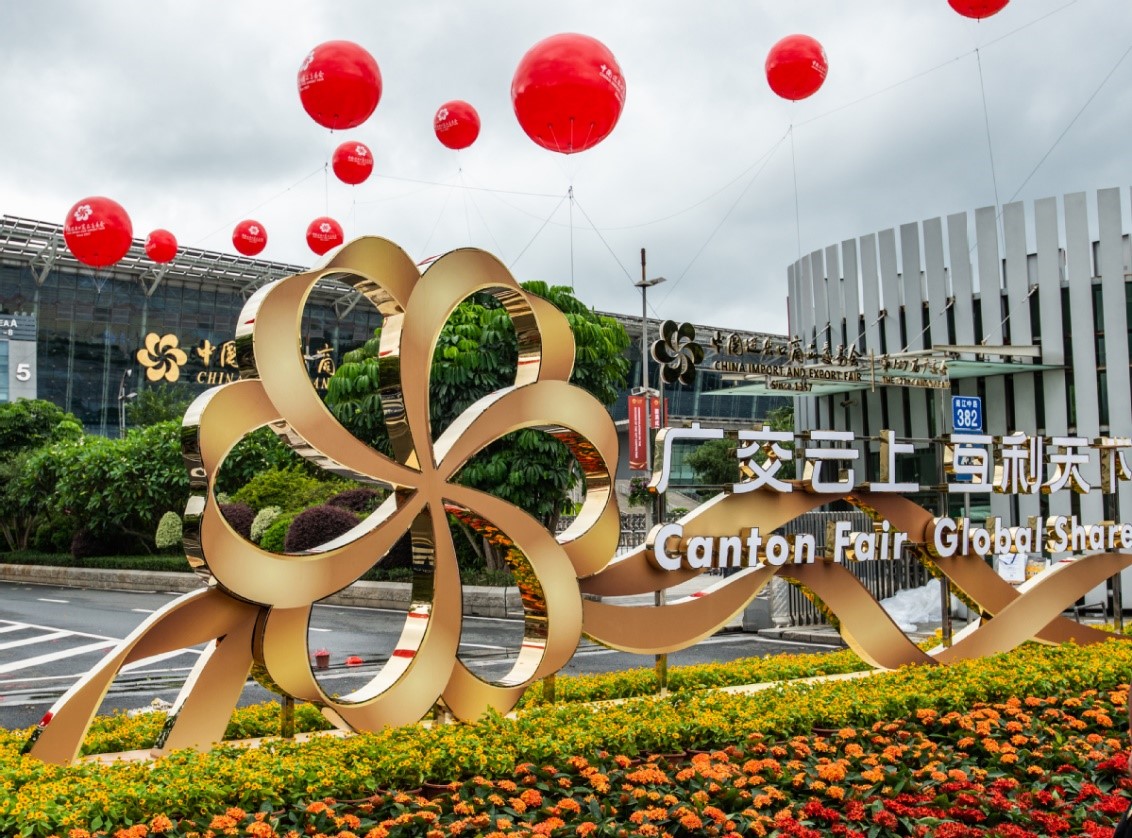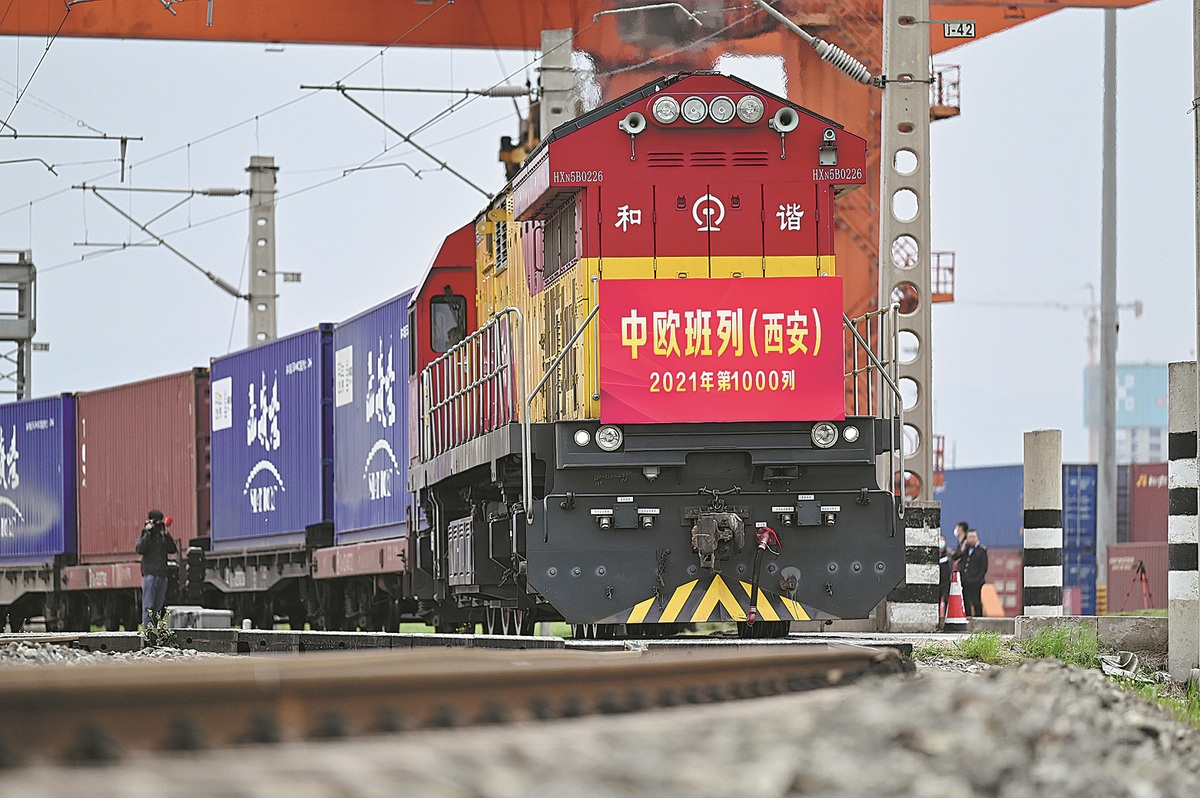1
Foreign trade, investment key to recovery

*A view of the China Import and Export Fair Complex in Guangzhou, capital of South China's Guangdong province, on June 14, 2020. [Photo/China Daily]
Premier Li urges further action to help fulfill orders, ensure supply, logistics.
China will take further measures to stabilize foreign trade and investment, with a view to consolidating the foundation of economic recovery, according to a decision made at the State Council's Executive Meeting chaired by Premier Li Keqiang on Tuesday.
Noting opening-up as China's basic national policy and foreign trade as a strong underpinning for stable growth and employment, the meeting underscored the imperative for redoubled efforts to stabilize foreign trade and investment.
"We are facing big pressure in keeping foreign trade and foreign investment stable, with a notable slowdown of imports and exports. The first and foremost issue is to help businesses secure orders, by using all policy measures available to the full extent, such as the China Import and Export Fair (Canton Fair), the China International Import Expo, overseas warehouses and cross-border e-commerce," Li said.
The meeting stressed the need to support enterprises in retaining orders and expanding market presence. Stronger efforts will be made to ensure energy and labor supply and logistics for foreign trade companies. Full support will be given when necessary to ensure the fulfillment of contracts.
Special funds for international economic cooperation and foreign trade will be used fully and at a faster pace. Services for companies to participate in overseas exhibitions and conduct business negotiations will be improved.
New forms of foreign trade will be promoted. A number of new integrated pilot zones for cross-border e-commerce will be established without delay. Greater support will be given to building overseas warehouses.
Goods transport between inland areas and coastal ports as well as domestic land transport will be made more efficient, to speed up trans-shipment and the inbound and outbound transport of goods. Industrial and supply chains will be kept secure. Unwarranted charges for port services will be continuously monitored.
"We must roll out signature projects of critical importance without delay, to galvanize foreign investment and bolster confidence and expectations," Li said.
The supply of production factors will be ensured to speed up the launch of key foreign-funded projects. Further measures will be taken to facilitate the border entry and exit of business personnel and technicians employed by foreign companies, as well as their families.
Leading provincial regions in foreign trade and foreign investment need to step up to their responsibilities, and better play their backbone roles. Related departments need to enhance coordination and services.
"The eastern coastal provincial regions account for nearly 70 percent of our country's foreign trade. Their leading role must be fully brought to bear, to contribute their part to the stable performance of foreign trade and foreign investment," Li said.
Media Source: China Daily
2
Improved railway helps to boost regional connectivity

*A train with 50 cars loaded with bikes, toys, dishwashers and other goods leaves Xi'an International Port in Xi'an, Shaanxi province, in April last year, headed for Kazakhstan as part of the China-Europe rail freight service linking China, Central Asia and Europe. [Photo/Xinhua]
China upgrades infrastructure to raise capacity for freight at border
Improved railway infrastructure between China and Kazakhstan has played a major role in the increased frequency of China-Europe freight train services, which has served to beef up regional connectivity and promote the Belt and Road Initiative.
There are three main routes and five border stations for China-Europe freight trains in western, central and eastern China. Two of these-on the western route-enter Kazakhstan from the Alataw Pass and Horgos Port stations in China's Xinjiang Uygur autonomous region.
To meet the growing demand for China-Europe freight train services, China carried out infrastructure upgrading to expand the capacity at these border stations.
Last year, more lines were built at Horgos for reload containers, enabling the station to handle the reloading of an additional three to four trains each day.
As a result, a total of 2,710 trains passed through Horgos last year, a year-on-year increase of 32.8 percent, according to the China-Europe Freight Train Development Report in 2021.
An expansion project has also been carried out at the Alataw Pass border station.
This year, the average daily traffic volume of China-Europe freight trains passing through these two stations increased by 20.7 percent compared with the figure in 2020, before the capacity expansion and renovation projects, according to China State Railway Group.
Capacity expansion also took place at Dostyk, the station on the Kazakh side of the border. A new reloading yard was put into operation last year with a designed capacity to reload 160,000 containers annually.
By May, the yard had been expanded to be able to handle 320,000 containers a year.
The report added that thanks to the China-Europe freight train services, Kazakhstan, which is the world's largest landlocked country, can easily access sea ports in China to send wheat to Southeast Asian markets.
It added that these freight train services open up a new channel for inland areas of Asia and Europe, helping them to better integrate into the global economy.
As of Aug 21, 10,000 freight trains had traveled between China and Europe, carrying 972,000 twenty-foot equivalent units of goods.
Media Source: China Daily
3
Starbucks charts expansion plan in China for more market share

* A Starbucks store in Hangzhou, Zhejiang province. [Photo by LONG WEI/FOR CHINA DAILY]
Starbucks plans to increase its store numbers by 50 percent to 9,000 stores by 2025 in China-its second-largest market-as well as double its sales and quadruple its operating income through efforts including store expansion, growth in omnichannel engagement and at-home and on-the-go coffee services.
This is part of the world's leading coffee house chain's Reinvention Plan which was unveiled during the company's biennial Investor Day conference on Tuesday.
The coffee chain operator, which has been outnumbered by homegrown brand Luckin Coffee this year, has grown nearly tenfold in the past decade on the Chinese mainland, on track to reach its goal of 6,000 stores by the end of this year.
Starbucks expects to continue robust store development in China, with net unit growth of about 13 percent annually.
By 2025, the company is expected to open a new store every nine hours to add 3,000 new stores in 300 cities in the country, said Belinda Wong, chairwoman of Starbucks China, during the conference.
In first and second-tier cities, Starbucks China is going to optimize its store portfolio and density in key trade zones. For example, at its reserve stores, Starbucks China is expected to elevate its connections with communities through smarter omnichannel services and operate about 2,500 green stores. The company aims to grow its registered members to 170 million by 2025 from its current 85 million.
Delivering locally tailored coffee innovations is key to the implementation of the plan, according to the company. In the next three years, Starbucks China is investing $220 million in launching its digital technology innovation enter in the country to further facilitate its digitalization of store operations and in-house technology and data infrastructure.
Jason Yu, general manager of Kantar Worldpanel China, said Starbucks' investment plan and its commitment to the Chinese market have shown strong confidence in the coffee sector.
"The efforts to further expand their footprint into lower-tier cities as well as to increase density in top-tier cities will continue to popularize coffee culture in the tea-drinking nation," Yu said.
More meaningful are Starbucks' attempts to diversify and optimize its store formats to make them more relevant and convenient for consumers, improving store efficiency.
"Starbucks still has competence in its all-round store portfolios, distribution channels and coffee memberships to help generate more revenue," Yu said.
"Most local brands will find it harder to compete with Starbucks in terms of scale and supply chains, despite their flexibility in innovations," Yu added.
Operating 7,195 stores by the first half year of 2022, Luckin Coffee has exceeded Starbucks in terms of store numbers, driving up two consecutive profitable quarters this year.
Amid fierce competition with local rivals, Starbucks sees the enormous potential in the specialty coffee market in China, as it has a higher demand for premium coffee. Coffee consumption per year has grown from 10 cups per capita in 2019 to 12 cups by the end of this year and is estimated to grow to 14 cups by 2025.
Starbucks has named Laxman Narasimhan as its new CEO, who will officially join Starbucks on Oct 1 this year and will work closely with Howard Schultz before assuming the CEO role and joining the board in April 2023. Schultz will remain a member of the board after the transition.
Media Source: China Daily
4
More than 1 million in East China evacuated as strongest typhoon to hit 12 Chinese provinces

* A walk in Ningbo, East China's Zhejiang province, is flooded by river water on September 14, 2022 as Typhoon Muifa hits the city. Photo: IC
Transportation and classes were suspended and more than 1 million people in Shanghai and other cities of East China's Zhejiang Province were evacuated on Wednesday as the country moved to its highest tropical cyclone alert level for Typhoon Muifa, the strongest typhoon to land in China so far in 2022.
The storm is expected to hit 12 provinces and cities with severe gales and rainstorms.
Experts warned of potential damage and disasters brought by Muifa due to the long time and large range of its influence, but noted that it can also relieve the severe drought that some regions along the Yangtze River have suffered because of the continuous high temperatures.
China's National Meteorological Center (NMC) on Wednesday morning issued the first red alert for a typhoon in 2022 as Typhoon Muifa approached East China.
Around 8:30 pm on Wednesday, Muifa landed in the coastal regions of Zhoushan in Zhejiang Province, with the maximum winds near the center being 42 meters per second, and the minimum pressure at the center being 960 HPA, which makes it the strongest typhoon to land in China so far this year.
It is expected to make a second landfall along the coast from Pinghu in Zhejiang to Pudong in Shanghai around Wednesday midnight.
Gales and rainstorms are expected to affect the East China region for at least three days and further move toward Northeast China. A total of 12 provinces and regions are expected to be affected. Cumulative rainfall in some areas is expected to reach 50 millimeters to 150 millimeters between Wednesday and Friday, with some parts hitting 350 millimeters or more.
Experts reminded that the strong power of Muifa could unleash torrential rain and the potential for damaging winds, as well as a disruptive ocean surge, suggesting that affected regions such as Zhejiang, Shanghai and Jiangsu should prevent the adverse effects of strong wind and rainstorms on urban operations, transportation, fisheries and offshore aquaculture facilities, as well as epidemic prevention and control.
The typhoon is also expected to relieve the recent severe drought in the middle and lower reaches of the Yangtze River that resulted from continuous high temperatures, and will benefit the storage of water in reservoirs and agricultural irrigation, Dong Lin, chief forecaster of the NMC, told the Global Times on Wednesday.
As of 9 pm, about 395,000 people in Shanghai had been relocated. The city's flood control headquarters raised the emergency response to level II at 4 pm. Nearly 838,000 people had been relocated in Zhejiang as of 10 am on Wednesday, according to media reports.
Ports along the coast of Zhejiang and Shanghai have been fully mobilized and contingency measures, such as shutting down dock yards, have been put in place. Multiple waterways in Ningbo city, Zhejiang and Shanghai, as well as train lines in the Yangtze River Delta region, were also suspended.
Influenced by Muifa, the airports in Ningbo, Zhoushan and Taizhou cities in Zhejiang canceled all flights on Wednesday, while all the passenger flights arriving at or departing from Shanghai's Pudong International Airport and Hongqiao International Airport were canceled after 5:30 pm on Wednesday.
Some cities in Zhejiang, such as Jiaxing and Shaoxing, suspended classes on Wednesday.
Ningbo in Zhejiang has decided to suspend the requirement of 72-hour normalized nucleic acid testing within the city until the typhoon emergency response is over, except for gateways to the city such as airports, railway stations, highway check points and service zones.
The State Flood Control and Drought Relief Headquarters raised the emergency response for flood and typhoon control to level III on Tuesday at noon and made arrangements for defense against the typhoon, while the China Meteorological Administration jointly issued a red alert for floods and a warning of geological hazards, along with the Ministry of Water Resources and the Ministry of Natural Resources.
Media Source: Global Times
5
Shanghai confirms 14-nm chips being mass produced now

Authorities in Shanghai, the hub of China's semiconductors industry, on Wednesday said 14-nanometer chips are now being mass produced in the city.
The achievement is a milestone for Shanghai in building a modern technology center, and a major event for China's chips-making sector to break the blockade of the US government, amid the intensified China-US tech competition, experts said.
Shanghai-based firms have achieved mass production of semiconductors with 14-nm process and made breakthroughs in 90-nm lithography machines, 5-nm etching machines, 12-inch large silicon wafers, central processing units and 5G chips, Wu Jincheng, director of the Shanghai Municipal Commission of Economy and Digitalization, said at a press conference on Wednesday.
It marks the first official recognition of the ability of Chinese companies to mass produce 14-nm chips, Xiang Ligang, an independent technology analyst, told the Global Times on Wednesday.
The validation also comes as a powerful response to an expanded US blockade on high-end chip exports to China, which will only accelerate China's breakthroughs in core technology, experts said.
"The broader the US blockades are, the faster that China will research and develop its own technology," Xiang said.
The Biden administration plans to broaden curbs on US shipments to China of semiconductors used for artificial intelligence and chip-making tools, Reuters reported on Monday.
The US Commerce Department has sent letters to companies including KLA Corp, Lam Research Corp and Applied Materials Inc, forbidding them from exporting chip-making equipment to Chinese factories that produce advanced semiconductors with sub-14-nm processes unless the sellers obtain Commerce Department licenses, according to the report.
While 10-nm has often been taken as a benchmark for advanced processes, for China, mature processes above 14-nm can meet the majority of Chinese market demands, Xiang said.
Chen Jia, an independent research fellow on strategy, told the Global Times on Wednesday that demand for 14-nm process in the industry is represented by new-energy vehicles.
The large-scale production of 14-nm chips in Shanghai will greatly help the development of such sectors as new-energy cars, smart cities, intelligent manufacturing and the Internet of Things, which will help China consolidate its advantage as the world's top manufacturing factory, Chen said.
Experts said that the 14-nam breakthrough shows that China will allocate resources for breakthroughs in more advanced manufacturing processes.
With the completion of Shanghai's industry cluster for the 14-nm chips, more advanced projects in the 7- and 5-nm processes will be accelerated, Chen said.
"The manufacturing of 7-nm chips in China is also progressing faster than expected," Xiang said.
Shanghai is the backbone of the nation's semiconductors industry, with a market size reaching 250 billion yuan ($35.91 billion) in 2021, accounting for 25 percent of the nation's total. More than 1,000 leading enterprises have settled in Shanghai, attracting 40 percent of the talent nationwide, officials said.
At the beginning this year, the Shanghai municipal government announced a set of new policies to bolster China's advanced chip-making capacity.
Media Source: Global Times